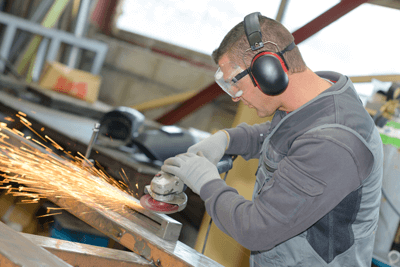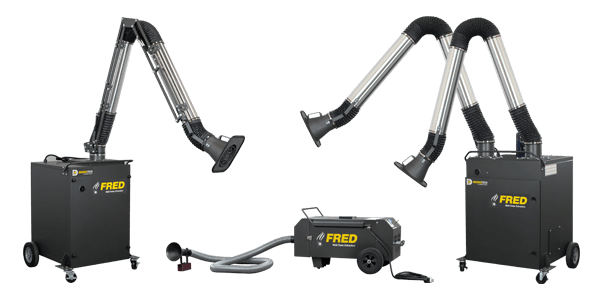Metal Fabrication
Overview
Converting sheet metal into structures or machines, the metal fabrication industry produces products ranging from metal parts to sophisticated machinery and equipment. Catering to many different sectors, metal fabrication supplies the aerospace, automotive, construction, ship building, mining and energy industries.
The Bureau of Labor Statistics estimates that approximately 1.425 million people work in metal fabrication. These workers include welders, cutters, solderers as well as cutting, punching and press brake operators.
The most common applications used in metal fabrication include cutting, grinding, welding, bending and assembly. One-stop fabrication shops or fab shops, provide a turnkey service for many of these processes in one facility. Rather than seeking out multiple vendors, contractors can employ a one-stop shop to fulfill all the requirements for their complex projects.
Cutting and Welding
One of the most common applications in metal fabrication, cutting involves the severing of sheets of metal into smaller sections or parts.  Whether cutting freshly made steel or preshaped metal, cutters employ a wide range of equipment including bladed saws, power scissors as well as laser and plasma torches.
Whether cutting freshly made steel or preshaped metal, cutters employ a wide range of equipment including bladed saws, power scissors as well as laser and plasma torches.
Frequently used in fab shops, plasma cutting creates an electrical arc with inert gas blown at high speeds. Some cutters use hand-held plasma torches to gouge holes or remove parts. But to get really fine, exact cuts, many fab shops opt for CNC plasma machines.
Using an automated computer numerical control (CNC), these machines make cuts with a straight barrel torch and a jet of hot plasma. Because of the extremely high temperatures involved, CNC plasma cutting produces microscopic particulate that can be very hazardous to worker health. Smaller particles are easily absorbed into the lungs of metal workers and as a result pose a more dangerous threat to their health. When these contaminants contain toxic metals as they do in fab shops, the health consequences are dire.
Laser cutting on the other hand, uses a high-powered laser beam to cut metal into various shapes or designs. Usually used on thinner sheets of metals, laser cutting may also involve a gas jet to disperse molten metal. While laser cutting creates less contamination and waste compared to other applications, it still produces highly toxic metals fumes that pose an immediate threat to worker health.
Another common fab shop application, welding joins together two separate metal parts using heat from an electric arc, or some other tool. Like plasma and laser cutting, welding produces a number of toxins that can potentially harm worker health when inhaled.
Hexavalent chromium or Cr6, is a byproduct of cutting and welding stainless or galvanized steel. A highly toxic carcinogen, workers exposed to Cr6 run the risk of developing a number of health conditions. Along with lung and nasal cancers, hexavalent chromium can cause:
- Skin and respiratory irritation
- Liver and kidney damage
- Nasal perforation and sores
- Birth defects
Other toxic materials that pose serious health risks to welders and cutters include iron, copper, zinc, nickel, manganese, aluminum, tin, beryllium, cadmium, lead and titanium. The smoke and fumes from these metals irritate the nose, throat and eyes. They can also potentially damage the brain, nervous system, lung and kidneys. Exposure to manganese can lead to managanism, a nervous system disorder with symptoms that mimic Parkinson’s. Some metals, like nickel, are carcinogenic and others like cadmium can be fatal.
Without proper protections in place, welders and cutters who work with galvanized steel also put themselves at risk of developing metal fume fever. Usually lasting no more than a day, this illness comes with flu-like symptoms such as fever, weakness, fatigue, chills, aches, nausea and chills.
The zinc released when welding or cutting galvanized steel poses other health risks as well. Inhaled in large quantities over a short period of time, zinc can be fatal. Other conditions caused by zinc fumes include:
- Skin, eyes, lungs and mucus membrane irritation
- Dermatitis, rashes and chemical burns
- Difficulty breathing
- Chest pain
- Tightness
Many of the dusts created from plasma and laser cutting are also combustible and present a serious threat of fire and explosion.
OSHA has a number of regulations in place to protect the health and welfare of welders and cutters. Besides personal protective equipment, OSHA recommends engineered controls that collect dust, smoke and fume at source. Diversitech offers a range of extractions arms, portable fume extractors and downdraft tables to keep you OSHA compliant. These systems collect toxins before they have a chance to contaminate indoor shop air and remain the trusted choice of North America’s largest manufacturers. For the safe capture of combustibles, one of Diversitech’s wet downdraft tables is recommended.
Grinding, Deburring, Sanding, Polishing & Buffing
Other common metal fabrication operations like grinding, deburring, buffing, sanding and polishing create dusts and particles  that pose a number of health risks. Knowing the kind of metal being ground, sanded or deburred is crucial in understanding how to best protect workers.
that pose a number of health risks. Knowing the kind of metal being ground, sanded or deburred is crucial in understanding how to best protect workers.
Besides being highly toxic when inhaled, some metallic dusts like aluminum, titanium and magnesium are combustible and can lead to fire or explosion if not handled appropriately. Employers must implement controls to safely capture these flammable dusts to mitigate the threat of catastrophic fire and explosion.
The majority of other health conditions caused by grinding and deburring dusts affect the lungs. But other organs are also vulnerable to disease. Grinding dust particles can potentially dissolve in the bloodstream, affecting the liver, kidneys and possibly the brain.
The list of health problems associated with grinding, sanding and deburring dusts is extensive. Along with less serious conditions such as headaches, chest pain, nausea or eye, nose and throat irritation, workers may develop:
- Pneumoconiosis (dusty lung)
- Black lung
- Silicosis
- Tuberculosis
- Kidney disease
- Lung cancer
- Respiratory damage
- Difficulty breathing
- Excess fluid in the lungs
- Lead poisoning
- Nervous system damage
Effective capture-at-source or ambient ventilation solutions remain your best options for controlling grinding, deburring, sanding, polishing and buffing dusts. Diversitech offers various downdraft tables and cartridge dust collectors to help fab shops control toxic dusts. For the capture of combustibles, we recommend one of our state-of-the-art wet downdraft tables .
Abrasive Blasting
Used frequently in metal fabrication, abrasive blasting is the process of shooting small particles of material at high velocities in order to clean, strip or imprint an object. Blasting is also an effective way to alter the texture or remove surface contaminants on a piece of metal. The type of blasted material can vary and includes sand, steel shot, plastic beads, walnut hulls or grit.
The process generates a large quantity of dust, not only from the blasting material, but also the base piece and its surface coating. These dusts pose significant health risks to workers, and in the case of some metallic dusts, may be combustible.
The health problems resulting from abrasive blasting directly relates to the materials used in the process. The dusts from the blasting material as well as the blasted object can be highly toxic if inhaled.
Many of the materials used in blasting processes that can cause lung damage in workers include:
- Coal slag
- Silica sand (crystalline)
- Garnet sand
- Copper slag
- Nickel slag
- Glass (crushed or beads)
- Steel grit and shot
Exposure to silica dust can cause silicosis, lung cancer and respiratory problems. Slags also may contain toxic metals like beryllium, arsenic and cadmium. All three of these metals have been known to cause cancer. In some cases, cadmium has been known to be fatal.
Diversitech understands the dangers blasting dusts pose to worker health. Our Airhawk Dust Collectors and EBM Dust Control Booths effectively capture these contaminants before they can do harm. To prevent the risk of fire and explosion, Diversitech’s line of wet dust collectors is a great option.
Powder Coating and Spray Painting
Once fabricated, most metal parts require either powder coating of spray painting to avoid corrosion and tarnish.  It’s for this reason many fab shops also incorporate these applications into their services.
It’s for this reason many fab shops also incorporate these applications into their services.
Powder coating processes spray dry powder containing a positive electric charge onto a negatively charged metal object. The process produces an electrochemical change and molds the powder directly to the unfinished metal. Once heated, that powder creates a durable, high-quality finish.
Another application that protects metal from rust and wear, spray painting is also frequently used to lengthen the life and improve the appearance of unfinished metal.
Both spray painting and powder coating produce volatile organic compounds (VOCs) that can negatively affect worker health. If not properly filtered, VOCs can lead to a wide range of health issues. Headaches; nausea; eyes, nose and throat irritation are all symptoms of VOC exposure. But with long-term exposure comes even more concerning health risks such as cancer as well as liver, kidney and central nervous system damage.
Spray painting also contains toxic metals and chemicals that pose additional health concerns when inhaled. Metals like chromium, cadmium and lead in spray paint can result in cancer; kidney, bone and lung disease; hormone disruption and brain damage. Paint chemicals such as isocyanates, toluene, petroleum naphtha and epoxy resins can lead to allergic reactions, organ failure and nerve and brain damage.
Besides the potential damage to worker health, powder coating processes also produce explosible materials. Failure to adequately contain these combustibles can result in fire and explosion putting workers at risk of injury or death. To protect workers, and prevent the destruction of company property, metal fabrication shops need to implement appropriate engineered controls for the capture of combustible materials.
Diversitech understands the dangers posed by powder coating and spray painting applications. Our FRED Overspray Master, Industrial Paint Booths and Benchtop Spray Booths effectively capture VOCs and other contaminants from powder coating and spray painting. For the safe capture of combustibles, we offer our Wet Dust Collection Booths.
